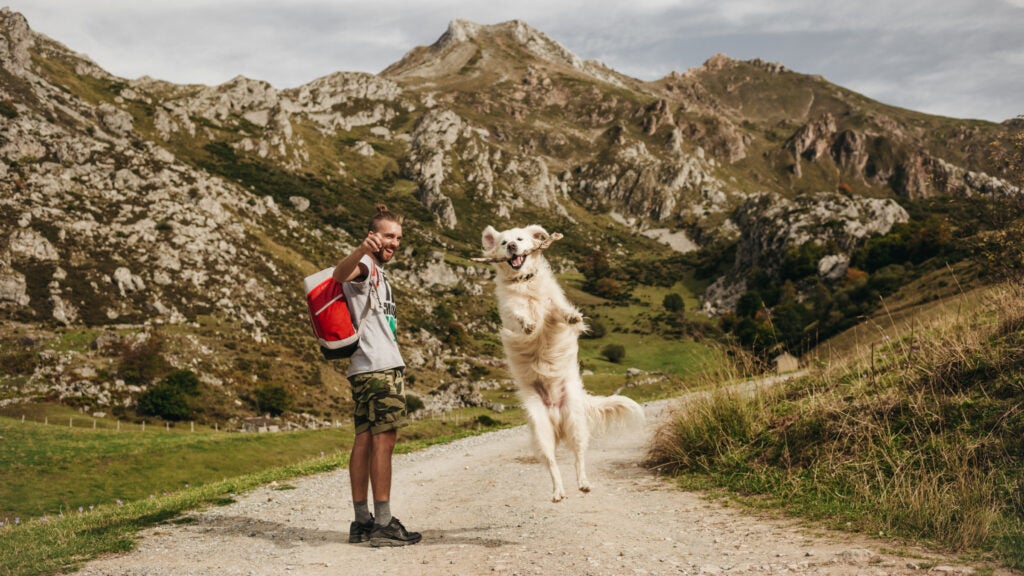Products You May Like
Heading out the door? Read this article on the new Outside+ app available now on iOS devices for members!
Download the app.
This past fall, I moved to a new city, found myself with zero hiking buddies, and made a grievous error: I assumed that my housemate’s dog would make a great stand-in. Her name is Tilly, she’s a three-year-old Australian shepherd, and she’s a total maniac.
Almost as soon as Tilly and I started hiking together, I discovered that hiking with a dog and hiking without a dog are very different experiences. Without a dog, I hike mostly in a straight line and at a consistent pace. I pay very little attention to trail-adjacent squirrel life. With a dog, all thoughts of maintaining an even pace go out the window. I’m either dragging or being dragged, often through the mud. I am suddenly very alert to the movements of overhead rodents.
Sometimes, Tilly and I spend several minutes walking in perfect harmony. She prances by my side. I feel like we finally understand each other. I congratulate myself on being an excellent dog trainer. Then, suddenly, my arm is half out of its socket and I’m getting yanked downhill, pinging from one side of the trail to the next in a pinball trajectory with no regard whatsoever for the wellbeing of bikes, children, or innocent joggers.
Embracing the chaos
After the first few hikes, I always came home angry and frustrated. All I wanted was consistent cardio, the kind that lets you turn your brain off and forget about your problems. But as the weeks passed and I continued to fail to make human friends, I found myself reaching for the leash again and again. Better a chaotic hike than a lonely one, I told myself.
Soon, I gave up all illusions about gaining fitness. I embraced Tilly’s erratic pace and just decided to roll with the punches instead of fighting her.
Against all odds, it paid off. Last week, I swapped dog hiking with human hiking for the first time since December. Without Tilly, I was actually able to pay attention to my pace, and I realized how much it had changed. Even on hills I felt springy and agile, and on flats I was able to hit and maintain a 3.5 mph clip. I was in better hiking shape than I’d been in a long time.

The science of the erratic workout
As it turns out, I’m not the only person to benefit from dog-like workouts. A number of studies suggest that short, random bursts of exercise—the kind dogs seem to advocate—can help you live longer, get stronger, and avoid hiking burnout.
For one thing, managing a dog on a leash requires more energy expenditure than hiking unencumbered. With a taut leash challenging your balance, you’re forced to activate the stabilizing muscles around your ankles and knees. That’s instrumental both for building strength and preventing injury.
The other benefit of letting your dog walk you is that you’re more likely to end up bounding through piles of leaves, over logs, through mud, and across other uneven surfaces. Seeking out this kind of terrain has been shown to boost hikers’ metabolic rates and require up to 28 percent more energy expenditure than walking in a straight line across a level path. In other words, if you let your dog lead the way you could end up getting a 28 percent better workout.
But the most unique thing about hiking with a dog isn’t usually the terrain, especially if you can keep your beast from straying off trail. For me, the biggest difference has been the pace. And research shows that Tilly’s arbitrary bursts of speed could be the most beneficial aspect of hiking with her.
In a 2015 study conducted by a team of Danish physiologists, 132 recreational runners were instructed to replace two of their weekly runs with a strikingly dog-like interval workout. It was called the 10-20-30 Workout and it involved low-effort cardio for 30 seconds, followed by medium-effort cardio for 20 seconds and then 10 seconds of madcap, all-out sprinting.
The runners who followed this plan ended up with drastically reduced weekly mileage—but significantly faster 5k times by the end of the study. They also had increased their VO2 max, a popular marker of cardiovascular fitness.
Joy-filled exercise
More recent research suggests that regular, timed intervals may not even be necessary for fitness gains. In a massive, seven-year study that monitored more than 25,000 peoples’ exercise habits using fitness trackers, scientists discovered that those who incorporated random bursts of exercise throughout their day tended to be healthier and live longer. You don’t need a dog to see gains: Just a two-minute run or a sudden sprint up a flight of stairs was enough for participants to see huge fitness benefits.
To me, there was something beautiful in that. It’s not only the rigorous gym grind that makes us healthier, this study seemed to say. It’s the things we only do when we’re too amped up on life to contain ourselves. A spontaneous dash through sprinklers with the kiddos. A random burst of energy on the bike ride home. A sprint around the yard with the dog.
Hiking with Tilly has made me fitter, but also happier. I’m more relaxed about pace than I’ve ever been. I’m as comfortable stopping to check out a cool tree as I am redlining up a hill when I feel like it.
In short, I hike like a dog now. And I’m a better athlete for it.
